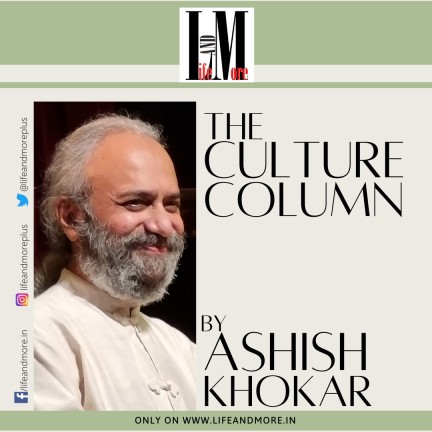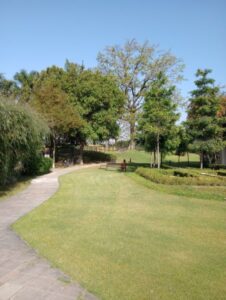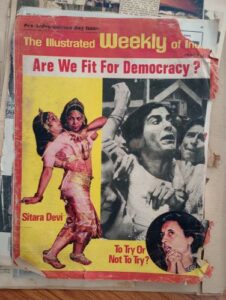Jolly Grant!

Summer is here!
You can see in wilting flower beds, the paper-like poppy petals slowly falling off and insects being out in full force! Makhi, Machchar, maha-ugly cockroaches in Hindi called Tilchitta. Did you know that?
As kids growing up in the Capital city in the 1960s, we were taken by our parents to almost every theatre, performance, music and book fair. So, Tilchitta was a third- year student’s production put up by NSD in their own studio. NSD was still at Rabindra Bhawan, Ferozeshah Road, Delhi. My father was in-charge then of NSD also under the SNA (Sangeet Natak Akademi). It had not broken off from the parent body. NSD means the National School of Drama. Not notional as it had become in recent years! Alkazi sahib the great, was the director. Nasir (ud-din Shah) was on stage with Sikri. For us young ones aged 12/14 in mid 1970s, it was akin to watching a porno play because there were lots of shirt less bed -related scenes. Cockroaches have freedom to be ANYWHERE that must’ve been the leit-motif of the play. Me too moment and movement was 50 years away. Gawd! Feels like I went back in time.
A visit to hills is a pure delight
Going to hills is like going back in time. It starts with the airports (like Jolly Grant is the name of airport for and nearest to Doon. Nothing British about it. Jauli was the name of the village gifted by the Ranas of Nepal so a grant! There was no Nepal then, so Pauri hills were one big part of the same undivided region. Soon this Doon airport will be called Atal Behari Vajpayee airport, as per resolution passed on March 20,2023) or railway station when you arrive from big city. Quaint, cute and unusual. People next. Unrushed, easy and simple. It is us city folks that spoil it. One can see new hotels coming up among old, rambling houses or bungalows. Less pollution for sure. Then too, less diversions. Roads are tiring as curvy and them local drivers know how to navigate but we city fellows think if Covid didn’t claim us, these hairy-bends will.
Far from the maddening crowds – my favourite childhood school book. As a student of History and English literature it was compulsory reading. Thomas Hardy. Today, when we think of that pastoral setting, lambs and sheep, slow crawl of time one can yearn for it and learn from going to the mountains. See trees full of fruits and flowers. Yes, there was a baby boom in USA long ago and here we have baby mangoes bloom every year!
This is how baby mangoes look like
All life is a lesson. Few learn from it. That’s why we suffer. Forget spirituality (most of my friends aver I should have let my long hair stay and started an ashram somewhere in the hills, made millions by rooking many by saying all that gyan I give for free anyway and laughed all the way to the bank. But that’s abusing dharma and spoiling my karma.) in real life too, such concepts apply.
So for thinkers, writers, procrastinators and assorted lazy bums far from the maddening crowd is a cure for insomnia, stress and BP. Try. Mind is free of daily routine and when the mind is free, the head is held high and firmly on one’s shoulders then thoughts flow loud and clear. Are we fit for democracy? A question asked aeons ago and even today. See the illustrated cover of the most popular news mag then.
Like it did at Pixstory hosted panel discussion on art writing and critiquing in digital age. Four Vedas were the panelists and a two dozen staff and students ; stars and successful folks listened to this afternoon session in Delhi in the density of a building in CP . That’s Connaught Place. The organisers tested audience IQ and GK and GPS systems by stating the building was on Barakhamba Road when it was on Curzon, also called Kasturba. The organisers were perhaps building appetite for the feast of food for thought that was to come later. The invite could’ve made things easier by adding ‘next to the American Centre /opp. British Council/ behind the Statesman’. Everyone in Delhi knows these landmarks. Chalo, live and learn.
So the panelists were all seasoned folks who brought various points to discussion. A dancer, a critic, a journalist and an editor. All very experienced with core competency. Each spoke loud and clear. The role of media, critic, publishing were discussed and some damned! Lots of learning curves appeared for all those present. Critics are assessors who have core competency and subject domain. They don’t just criticise! But guide and help art grow. A journalist is an all-rounder who can write on fashion, food and finance with equal ease. They are trained to say their piece objectively. An editor edits. Ideas, thoughts, language. Has an over view.
Kumar Gandharva
Dancers (of all the artists) love not only captive audiences but ideally want captive critics too! That’s because their shelf life is rather short. A painter can paint and sell anytime later. Even posthumously. Musicians record and have an end product. Ditto for films. Dancers? Very fragile and transient art. So one must have a core affection for art of dance. Treat it with kid gloves. A musician can sing without a lung like Kumar Gandharva did or a painter paint without an eye like NS Bendre did but a dancer without a hand or foot? There are one or two exceptions but not the norm. Dance is for the moment. Even a film can’t do justice to it.
One young budding writer had many concerns at the end of the session one didn’t have the time to elaborate upon, so one can only encapsulate 50 years of work in field as: Be kind to the art. Artists come and go. Ten good reviews most won’t remember but one not- so- pleasing line, most do. They are also human, after all. One must have empathy for arts and artists as they are fragile items. They make a nation’s cultural identity and scape. But they are doing no one a favour so don’t molly-coddle them. Veterans have spent a lifetime in field so handle with care! But stick to your convictions for that’s all you be left with in the end if one is not a PR agent. Those who write to please have done biggest damage to the field. Don’t sell your self for a ticket to nowhere. Stick to the course. Who doesn’t like praise but then art is bigger than the artist/e. Your work should speak for your worth. 2000 followers on social media mean nothing. Virtual world is virtual. Best to keep distance from the subject; don’t socialise overmuch. Don’t accept gifts or inducements. That way you are bought in their mind, no lunch being free. Your freedom to think and write honestly are compromised. Be respectful, even nice and courteous in public but when you wield your pen or PC keys, be truthful and honest. That will go a long way to earn real reputation and respect. Try not to be part of any groups or gangs. Listen to all; do your own. Stick to professional behaviour. It will go a long, long way. I speak with experience of almost five decades.
We love to ape the West and often quote examples from abroad. ‘This is what critics do in America or Europe’. But the eco systems are different too. Critics are read not seen. Definitely not in the front row! One can’t call them anytime or drop home to discuss the last performance or to complain about fellow competitors. No one can mess with them. One review and the whole season of a production can be made or ummade. That’s because big money is riding on them. Like a film production. Publications also stand by their writers and critics. Above all else, the society values the arts and artists. And pay their way. Not this free come-one come -all invite culture.
In India, since we are truly democratic, anything goes! First of all, most artists want attention not really an appraisal. Most shows are single shows or stand alone, not always a commercial success story. There are no real producers. So much personal money, energy and effort goes into a show. For what? Self indulgence? Name, fame? Awards ? Or just being in the market? To get more students. But for real gurus it can also be a plain devotion to art. There is a clear generational divide. Don’t forget in the 1950s there were three stars in each form then five in the sixties, seven in the 1970s maybe eight in the 80s and today? Everyone is a star! By being on social media they have followers and fans. So, there is no quality check. Who decides gold standards? All metals shine! But unknown eyes see all, that’s why picky few succeed, get celebrated and go abroad often to earn big bucks. Reputations take decades to build and can be lost in a day. Look at la affaire Kalakshetra.
So in India, a review coming after a week or month is of no real use except as patronage tool to go on government tours or important festivals. For that one needs the printed word. In India, most important critics also sit on many committees that decide awards and rewards; tours and grants so their importance also comes from that. Then too, since the stock is the same – critics and editors – support each other when an artiste gets high and mighty. India is an ultimate art work in progress. This session had an hour dedicated to Q&As so lots of minds were at work. This was a most meaningful exchange in recent times. If you missed it catch up on Pixstory or narthaki.com Facebook or meta data bytes.
Biting problem today is too much information on the digital highway. Who can tell a story as is? Without flowering it or diluting it? Without adding or padding? If truth be told what’s true anymore? Young India is bright but first it have knowledge? Information is not knowledge.
Knowledge is a lifelong process. I see seasoned teachers still wanting to learn more. Dancers still wanting to create more. Writers thinking of new angles to an old story. Like this one!
One per cent of Indians are linked and connected in India. Not digitally but in real terms. So if you know someone in one city or circle then likelihood of your knowing ten more in each city it there. Try. Either it is school connections or college; family or friends. This amazes most average foreigners. They can’t believe we were connected long before the digital age came on us. Through caste and creed; village and need.
Need is to create anew. Old order changeth. We need new folks in different walks to start taking charge. Young India has lots of energy. It NEEDS to be channelised and directed. That’s our national resource. Acche din ayenge!
He also edits and publishes attenDance, the yearbook, now in its 23rd year.
India Today hailed him as the gold standard of art writing and critiquing.









2 Comments
Enjoyed every bit of it. Aptly researched and presented with great deal of hardwork. A thought provoking article. Kudos..
I attended the wonderful discussion of the four panelists -Ashish Khokar ji, Anita Ratnam ji ,Ranjit Sahay ji and Ranee Kumar ji, the four Vedas! My main thought was: All four were Tamilians ! Not a single North Indian was worthy to be on this important talk show? Only Ashish ji can be called so, as half Sikh.I was curious to know the answer to which Ashish ji gave a very simple conclusion and said that I have worked a lot of time in Delhi, Punjab etc and we all are human beings, I felt that every young artist should be a part of this discussion , because listening to scholars leads to a different perspective.